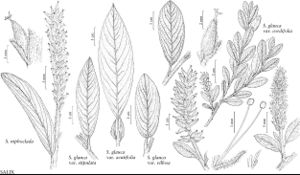Salix glauca
Sp. Pl. 2: 1019. 1753.
Plants 0.2–6 m, not clonal. Stems erect or decumbent; branches brownish, yellowbrown, gray-brown, or redbrown, villous or pilose to glabrescent; branchlets yellowbrown or redbrown, sparsely to densely villous or tomentose to glabrescent. Leaves: stipules (marcescent or not), foliaceous or rudimentary on early and late ones; petiole (usually deeply to shallowly grooved adaxially), 1–27 mm, (much longer than subtended bud); largest medial blade usually hypostomatous, sometimes hemiamphistomatous or amphistomatous, usually narrowly elliptic, elliptic, usually oblanceolate or obovate, sometimes narrowly oblong or obovate, 27–82 × 6–39 mm, 1.4–4.8 times as long as wide, base usually cuneate or convex, sometimes rounded, rarely subcordate, margins slightly revolute or flat, usually entire, apex acute, acuminate, convex, or rounded, abaxial surface densely villous or villous-silky, tomentose, short or long-silky, or pilose, hairs usually wavy or straight, sometimes curved, adaxial usually slightly glossy, sometimes dull, moderately densely villous, pilose, or long-silky to glabrescent; proximal blade margins entire or serrulate; juvenile blade sparsely or densely villous, tomentose, or long-silky abaxially. Catkins: staminate 14–53 × 5–17 mm, flowering branchlet 1–25 mm; pistillate densely to sometimes loosely flowered, slender, stout, subglobose, or globose, 15–83 × 7–21 mm, flowering branchlet 2–37 mm; floral bract tawny, brown, bicolor, or greenish, 1–3.4 mm, apex convex or rounded, entire, abaxially hairy, hairs wavy, crinkled, or straight. Staminate flowers: abaxial nectary 0.1–1 mm, adaxial nectary narrowly oblong, oblong, square, ovate, or flask-shaped, 0.5–1.3 mm, nectaries distinct, or connate and cupshaped; filaments distinct or slightly or partly connate, glabrous, or hairy on proximal 1/2; anthers 0.4–0.8 mm. Pistillate flowers: abaxial nectary absent, adaxial nectary usually narrowly oblong, oblong, or ovate, sometimes flask-shaped, 0.4–1.8 mm, shorter to longer than stipe; stipe 0.3–2.8 mm; ovary pyriform or obclavate, densely villous, tomentose, short-silky, or pubescent, beak usually gradually tapering to styles, sometimes gradually tapering to or slightly bulged below styles; ovules 6–22 per ovary; styles connate to distinct 1/2 their lengths or more, 0.3–1.6 mm; stigmas flat, abaxially non-papillate with rounded tip, or slenderly or broadly cylindrical, 0.2–0.8 mm. Capsules 4.5–9 mm. 2n = 76, 95, 114, 152.
Distribution

Alta., B.C., Man., N.S., N.W.T., Nunavut, Ont., Que., Sask., Yukon, Alaska, Colo., Mont., N.Mex., Oreg., Utah, Wash., Wyo., Eurasia (China [Altay Shan]), Eurasia (Chukotka), Eurasia (Mongolia), Eurasia (Novaya Zemlya), Eurasia (Russian Far East), Eurasia (Sakhalin), Eurasia (Scandinavia), Eurasia (arctic), Eurasia (e), Eurasia (w Siberia)
Discussion
Varieties 5 (4 in the flora).
Occurrence of Salix glauca is disjunct in western Siberia; var. glauca is known from Scandinavia.
Salix glauca is ubiquitous, highly polymorphic, and polyploid. It appears to have four major variations that are treated in different ways. European floras have treated it as an undivided polymorphic species(A. K. Skvortsov 1999), as several distinct species (K. H. Rechinger 1964b), or as comprising several subspecies (Rechinger 1993; G. W. Argus et al. 1999; B. Jonsell and T. Karlsson 2000+, vol. 1). In North America, Argus (1965) treated the four central tendencies as widely intergrading “phases” of a single species, later adopting varietal rank, whereas E. Hultén (1968) recognized them as subspecies. In view of the fact that the four elements are confluent over wide areas, there may be some merit in recognizing them as informal phases, but varietal rank is used here.
All specimens from Iceland named Salix glauca are S. arctica and those from Svalbard, Norway, are S. lanata Linnaeus.
The major reason for the high variability within Salix glauca seems to be high, and probably recurrent, polyploidy. Tetraploids, pentaploids, hexaploids, and octoploids are known in the species, and two of the subspecies include three ploidal levels. There also are intergrading geographical variations that are the basis for the recognition of infraspecific taxa.
Hybrids:
Salix glauca forms natural hybrids with S. arctica, S. arctophila, S. ballii, S. barclayi, S. boothii, S. brachycarpa, S. eastwoodiae, S. myricoides, S. niphoclada, S. pedicellaris, and S. planifolia.
The following key will help identify the varieties, but there are extensive areas of overlap among them and many intermediates.
Selected References
None.
Lower Taxa
Key
| 1 | Stipules often marcescent, foliaceous on late leaves, usually prominent, linear, narrowly elliptic, or lanceolate, 2-17 mm; branches red-brown or gray-brown or brownish; branchlets densely villous to glabrescent; proximal blades: margins entire; floral bracts 1.2-2.5 mm; staminate flowering branchlets 1-14 mm; ovaries obclavate or pyriform; Alaska, Canada | > 2 |
| 1 | Stipules sometimes marcescent or rudimentary, if foliaceous, usually inconspicuous, oblong, elliptic, or ovate, 1-8(-10) mm; branches usually yellow-brown or red-brown; branchlets usually sparsely villous or tomentose; proximal blades: margins entire or serrulate; floral bracts 1-3.4 mm; staminate flowering branchlets 1.5-25 mm; ovaries pyriform; northern Canada east of Mackenzie River, Greenland, Rocky Mountains | > 3 |
| 2 | Shrubs, 0.3-1 m; branchlets densely villous; petioles 1-9 mm; largest medial blades: apex acute, sometimes acuminate, or convex, adaxial surface moderately densely villous, or long-silky to glabrescent; staminate catkins 14-26 mm; filaments distinct or partly connate, glabrous or hairy on proximal 1/2; pistillate catkins stout to subglobose, flowering branchlets 2-19 mm; stipes 0.4-1.8 mm; Alaska, Northwest Territories, w Nunavut, n Yukon. | Salix glauca var. stipulata |
| 2 | Shrubs, 0.3-6 m; branchlets soon becoming pilose or glabrescent; petioles 4-27 mm; largest medial blades: apex acuminate to convex, adaxial surface often sparsely long-silky or pilose; staminate catkins 19-45 mm; filaments distinct, glabrous; pistillate catkins slender to stout, flowering branchlets 3-37 mm; stipes 0.5-2.8 mm; c Alaska, British Columbia, Northwest Territories, Yukon. | Salix glauca var. acutifolia |
| 3 | Stipules 0.9-2.8-8(-10) mm, sometimes marcescent; floral bracts usually brownish; largest medial blades: petiole 3-14 mm; Alberta, British Columbia, Rocky Mountains, Saskatchewan to New Mexico. | Salix glauca var. villosa |
| 3 | Stipules 1-2.1-4 mm, usually deciduous (in autumn); floral bracts usually tawny; largest medial blades: petiole 2-9 mm; c, e Canada, Greenland, St. Pierre and Miquelon. | Salix glauca var. cordifolia |
